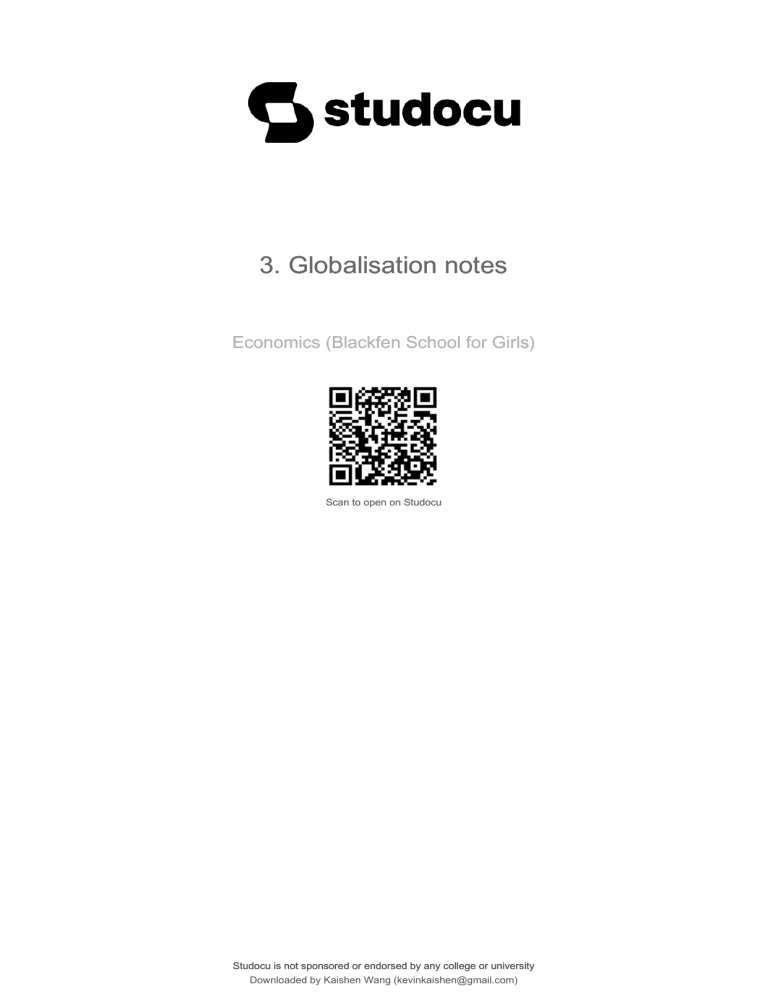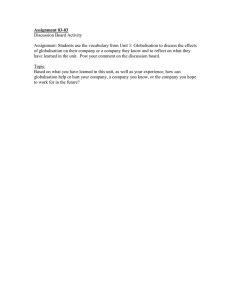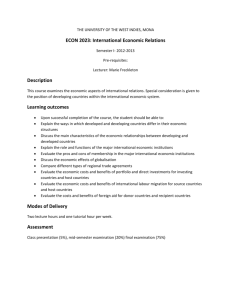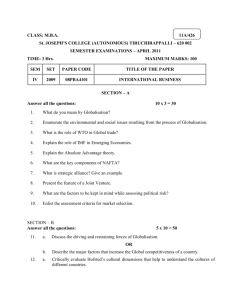
lOMoARcPSD|8963664 3. Globalisation notes Economics (Blackfen School for Girls) Scan to open on Studocu Studocu is not sponsored or endorsed by any college or university Downloaded by Kaishen Wang (kevinkaishen@gmail.com) lOMoARcPSD|8963664 Globalisation notes Please read and make notes on Globalisation. You should ensure you are clear on: What is globalisation (its characteristics) The causes of globalisation The benefits of globalisation The costs of globalisation. In analysing globalisation, make sure you cover globalisation’s impact on markets for Goods & services (trade) Labour (migration) Capital (flows of finance in the global financial markets, and of investment like FDI). In evaluating globalisation, it is useful to distinguish between the impact on developed countries and developing countries (usually defined by GDP/capita as High-Income and Low-Income Countries). What is globalisation Globalisation is the ever-deepening integration of the world’s markets. It can be analysed as: trade in goods & services between countries, the migration of people between countries, and the ability to save and invest across borders. Characteristics of globalisation include: an increase in world trade enabled by lower transportation costs and trade liberalisation. Economic theory suggests that countries specialising and trading surplus production should be associated with a global welfare gain (and indeed the proportion of the world’s population living in “absolute poverty” has fallen from 44% in 1988 to 16% in 2012 – this is a ‘killer fact’ you should learn!); Increased capital flows such as FDI, as finance capital seeks the highest risk-weighted return on a global basis; Increased migration between countries, as labour seeks the highest return for its skills on a global basis; The development of global brands and Multi-National Corporations (MNCs) seeking larger export markets and economies of scale, as well as lower production costs; Spatial division of labour, as MNCs “off-shore” stages of the production process to those countries with a comparative advantage in that process: e.g. iPhones designed in the USA, assembled in China. Resources: Textbook Unit 79 Page 23 of my ‘International Economics Notes’ http://www.tutor2u.net/economics/reference/globalisation 1 Downloaded by Kaishen Wang (kevinkaishen@gmail.com) lOMoARcPSD|8963664 Causes of globalisation You must ensure your notes cover Technological change, such as communications & transport technologies, innovations like containerisation for transporting bulk goods, and of course online technology enabling communication and the delivery of services; The role of MNCs in “off-shoring” manufacturing and business processes to lower-cost countries, and in seeking export markets for their products; The rise of trade blocs such as the EU which has increased cross-border trade between member states (“trade creation”) The global banking system and deregulation of key financial centres such as New York and London, which has enabled finance to flow wherever there are investment opportunities – enabling the financial contagion which caused the 2008 financial crash and Credit Crunch The work of the WTO in reducing protectionism worldwide Global migration, as workers in less developed economies seek opportunities in more developed countries; with consequent loss of skills to the emigrants’ countries, and lower wages and more competition for jobs in the destination country. Resources: Textbook Unit 79 Page 23 of my ‘International Economics Notes’ http://www.economicshelp.org/blog/401/trade/what-caused-globalization/ Benefits of globalisation You must cover the key benefits of globalisation to developed countries: Higher living standards and global welfare gain as countries are able to specialise in goods in which they have a comparative advantage Lower production costs and greater economies of scale for MNCs, boosting profits, dividends and productive and dynamic efficiency Lower-cost imported raw materials for firms Cheaper prices for consumers, and greater consumer choice increasing allocative efficiency More competition between firms (as domestic firms must compete with imports) Labour migration should increase the supply of labour, reducing wages and hence production costs for firms. It should also enable skills gaps in the domestic economy to be filled, raising productivity. And to developing countries: Bigger markets for developing countries’ exports Investment as MNCs off-shore production to developing countries, with consequent job creation, tax revenue and other multiplier effects Technology transfer from FDI Wider consumer choice as MNCs sell to developing countries’ consumers Higher living standards and poverty reduction. 2 Downloaded by Kaishen Wang (kevinkaishen@gmail.com) lOMoARcPSD|8963664 Resources: Textbook Unit 79 Page 24 of my ‘International Economics Notes’ http://www.economicshelp.org/blog/81/trade/costs-and-benefits-of-globalisation/ Costs of globalisation You must cover the key costs of globalisation to developed countries: Cheap imports may under-cut domestic producers who will reduce output as domestic consumers substitute cheaper imports, increasing (structural) unemployment Domestic firms may off-shore production to lower-cost countries, creating domestic (structural) unemployment Environmental costs of increased global output, consumption and transportation (pollution, global warming) – see ‘Environmental Kuznets Curve’; Cultural diversity may be reduced as e.g. McDonalds and Coca Cola displace indigenous cuisines; Migration, while increasing the labour supply in certain low-skilled occupations, will result in lower wages in those occupations and lower living standards for domestic workers in those occupations; it may also result in a burden on domestic public services such as schools and hospitals; and potentially declining social cohesion. And for developing countries: Exploitation of low-wage workers and weak health & safety standards to reduce MNCs’ production costs (see Rana Plaza sheet) Primary product dependency, as developing countries’ economies become ever more dependent on a few primary sector exports (combined with ‘Dutch Disease’ as foreign demand for raw material exports bids up the exchange rate and makes other exports less price-competitive – reinforcing the country’s dependency on the raw material export) Domestic firms unable to compete with MNC (who have gigantic economies of scale) “Footloose” MNCs’ ability to move production away from a host country to even lower-cost countries; the ‘race to the bottom’ as large MNCs bargain with developing countries to locate factories in that country in return for lower tax rates and weak health & safety regulation. Resources: Textbook Unit 79 Page 24 of my ‘International Economics Notes’ http://www.tutor2u.net/economics/reference/globalisation-evaluating-benefitsand-costs For a much more detailed and textured discussion of globalisation see this revision presentation from Tutor2u http://www.slideshare.net/tutor2u/a2-macro-aspects-ofglobalisation-2015 3 Downloaded by Kaishen Wang (kevinkaishen@gmail.com)



